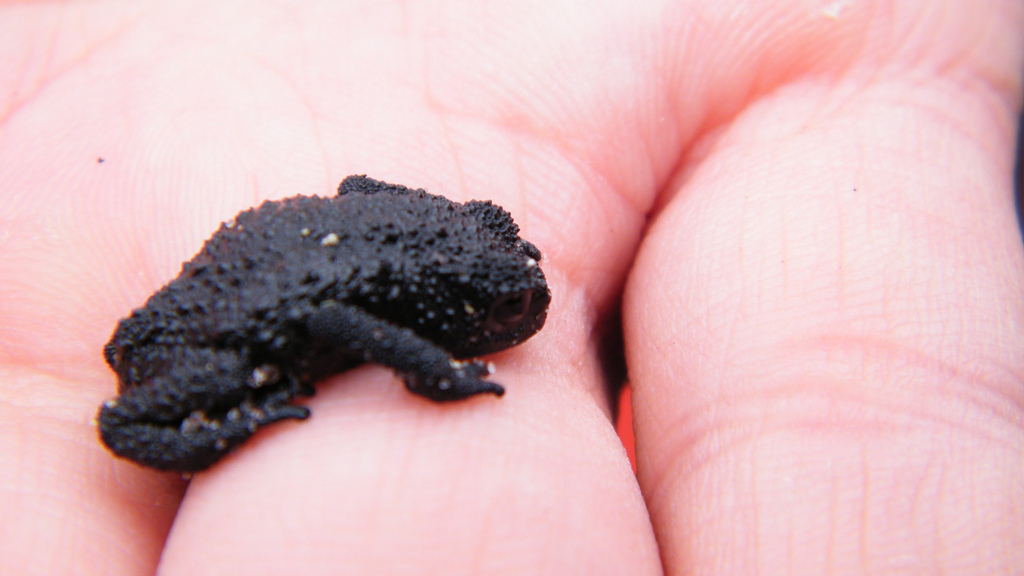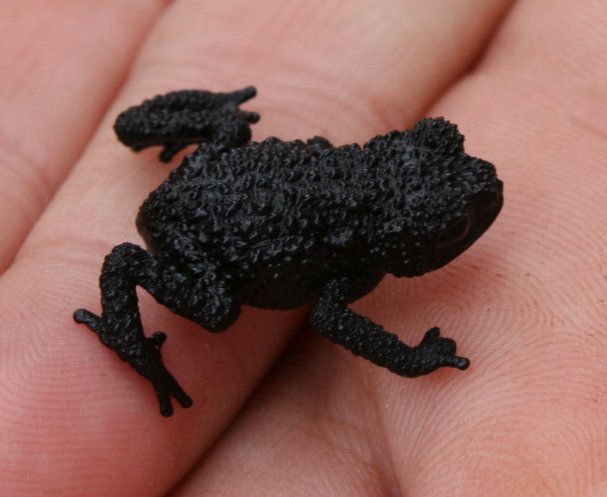Anomaloglossus roraima: The Elusive Jewel of South America’s Lost World#
In the lush, mist-covered forests atop the iconic Mount Roraima, a remarkable yet diminutive amphibian thrives, hidden carefully beneath the leafy forest floor and crystal-clear streams. Known scientifically as Anomaloglossus roraima, this captivating frog is more than just another tiny amphibian. It is a living symbol of South America’s unique evolutionary history, a species intricately adapted to its remote and specialized habitat. Discovered relatively recently, this amphibian is still shrouded by mystery and curiosity, epitomizing the secret lives that nature so adeptly conceals.
At first glance, this tiny creature – rarely exceeding the length of a thumbnail – might seem insignificant. Yet, a closer look reveals an amphibian marvel with shimmering colors, surprising behaviors, and a critical role in maintaining the delicate ecological balance of its habitat. Let’s explore the remarkable world of the Anomaloglossus roraima, a frog that reminds us why each species, big or small, deserves appreciation and protection.
Taxonomy and Classification#
Anomaloglossus roraima belongs to the diverse frog family Aromobatidae, a group renowned for their complex evolutionary lineage and fascinating diversity. These frogs are traditionally distinguished by their vibrant colorations, secretive lifestyles, and close association with mountainous or geographically isolated habitats.
The genus Anomaloglossus itself consists of several closely related species primarily distributed in highland forests and “tepui”-type ecosystems—so-called “islands above the rainforest” characterized by flat-topped mountains cut from the surrounding lowlands by vertical cliffs. Of these isolated tepui environments, Mount Roraima is perhaps the most famous, known worldwide for its spectacular landscapes and unique biodiversity. The isolated environment has prompted speciation events that gave rise to numerous endemic creatures, among them Anomaloglossus roraima, uniquely adapted to the specific environmental pressures and conditions of this stunning geological wonder.
Natural Habitat#
Hidden within the spectacular and dramatic landscapes atop Mount Roraima, situated at the borders of Venezuela, Guyana, and Brazil, Anomaloglossus roraima occupies an incredibly specialized ecological niche. This frog thrives at elevations ranging from approximately 1,800 to over 2,800 meters, where climate and vegetation undergo significant changes, forming a distinct ecological community rich in endemic flora and fauna.
The habitat of Anomaloglossus roraima is predominantly associated with pristine, moist, leaf-littered undergrowth within tepui forests and along clean, slow-moving freshwater streams which snake through the rugged terrain of Mount Roraima. These cold, clear waters characterized by constant humidity and stable temperatures throughout the year offer an ideal breeding ground and protective shelter.
At night, the forest comes alive under the gaze of distant stars, cloaked in mist and hauntingly beautiful. Here, beneath the humidity-drenched foliage, A. roraima emerges, subtly interacting with this lush and untouched forest ecosystem. Such conditions have developed through geological time, eventually shaping a highly specialized microhabitat tailored specifically to this tiny amphibian’s survival needs.
Physical Characteristics#
Despite its diminutive size, Anomaloglossus roraima captivates observers through its extraordinary appearance. Adult frogs generally measure only 18-25 mm—smaller than an average fingernail. Yet, nature rewarded these frogs with remarkable pigmentation, varying from deep browns and olives to warmer orange-green tones enhanced with shimmering gold flecks and subtle streaks.
The overall body shape of this species is designed for life in moist leaf litter. Their slender limbs equipped with delicate toes allow precise navigation through dense vegetation and debris. Their skin, covered in smooth, moisture-retaining layers, glistens under shafts of sunlight penetrating the canopy, exhibiting effectiveness at camouflage among damp leaves and moss-covered rocks.
Their coloration undoubtedly contributes to predatory evasion, making it challenging to spot the elusive frog both by day against moist substrates or by night under dim starlight. This cryptic camouflage is a beautiful illustration of nature’s artwork, simultaneously alluring and essential—a silent reminder of powerful evolutionary adaptations in play.
Behavior and Life Cycle#
Like most Aromobatidae species, Anomaloglossus roraima exhibits fascinating behaviors rarely glimpsed by casual explorers. These frogs possess a primarily terrestrial inclinations but maintain strong ties with aquatic habitats, particularly for critical phases of their reproduction.
Diet and Foraging Habits#
A. roraima proves an adept predator despite its small size. It searches methodically through the detritus layer for insects, mites, small invertebrates, and other minuscule prey, darting swiftly yet quietly to seize these mobile victims. The abundance of arthropods inhabiting the tepui forests ensures a steady and diverse diet, crucial for maintaining the frog’s metabolism in cold, moisture-saturated conditions of high-altitude environments.
Breeding Behavior and Parental Care#
The reproductive cycle of Anomaloglossus roraima reveals intriguing adaptations associated with their mountaintop surroundings. After seasonal rains, males initiate a melodious chorus, their rhythmic calls reverberating gently through mist-covered vegetation, alerting females ready to mate. Courting pairs meet near secluded spots adjacent to small streams, rock crevices, or hollows in moss-heavy forest floors.
Unlike typical frogs, these Aromobatidae frogs demonstrate considerable parental investment and sophisticated reproductive strategies. Eggs are deposited thoughtfully in shallow depressions, carefully chosen to prevent desiccation and predation. Once hatched, parent frogs display dedicated behaviors, caring tenderly for tadpoles, relocating them on their backs to optimal pools or safe water pockets protected from threats. This extraordinary parental attentiveness marks the essence of successful adaptation in an unpredictable environment.
Ecological Role#
The existence of Anomaloglossus roraima is deeply intertwined with the health and stability of the Roraima ecosystem. As both predator and prey, this tiny amphibian holds significant ecological significance, driven primarily by the delicate food web prevailing on these isolated mountaintops.
Insectivorous behavior ensures the population control of invertebrates, indirectly regulating leaf decay and nutrient cycling, which preserves a balanced forest floor ecosystem. Moreover, the frog itself constitutes a vital prey item for larger predators, thereby contributing directly to the food web dynamics. Ecologically sensitive, changes in the population dynamics of this species might indicate shifts or disruptions within the fragile tepui habitats, highlighting the frog’s priceless ecological value as a bioindicator species.
Threats and Conservation Status#
Due to extremely restricted distribution and specialized habitat requirements, Anomaloglossus roraima stands vulnerable to environmental perturbation. Though not yet formally assessed by the International Union for Conservation of Nature (IUCN), ongoing research suggests that climate change, habitat disturbance, and invasive species pose substantial future threats—including altered rainfall patterns, rising temperatures, and increasing human visitation to Mount Roraima.
Proactive conservation measures and scientific monitoring are advisable to guard this distinctive and irreplaceable species. Strong habitat protections, sustainable tourism guidelines, and collaborative international research programs—incorporating efforts from Venezuela, Brazil, and Guyana—could significantly support long-term survival of this unique amphibian.
Cultural and Scientific Significance#
Mount Roraima occupies deep cultural significance, capturing imaginations with its legendary mystique and isolated grandeur. Indigenous communities surrounding this biodiversity hotspot regard the mountain—and consequently its flora and fauna—with great reverence. Although specific folklore related to A. roraima remains unrecorded, the diversity and distinctiveness it represents unquestionably enrich the mountain’s cultural, educational, and ecological heritage.
Conclusion: Protecting the Living Jewels of Mount Roraima#
Anomaloglossus roraima embodies beauty, complexity, and ecological harmony of South America’s high-elevation forests. By deepening our understanding and appreciation for this captivating amphibian, we align ourselves closer to nature, ultimately protecting the astounding wilderness that makes our planet an enduring wonder.
As conservationists, nature enthusiasts, and curious minds, we share responsibility for safeguarding the delicate balance of species like this petite frog, ensuring their continued presence in the inspirational realms of Mount Roraima. Let this tiny frog remind us all that even the smallest life can profoundly illuminate the richness and fragility of biodiversity, urging us to champion their continued existence.













